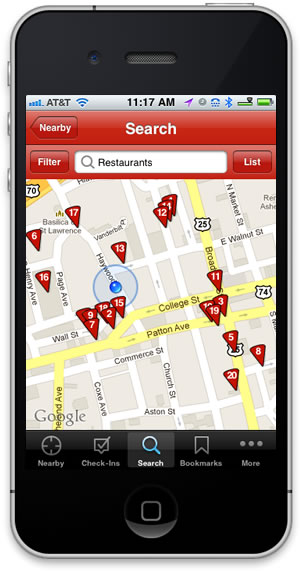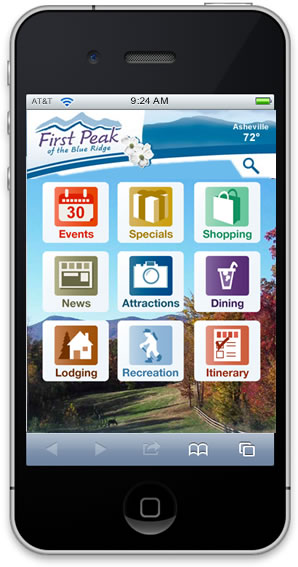
Mobile App or Mobile Site?
Are you like many destinations that have been holding out and waiting to decide on how and when to get started in mobile marketing? I hate to be the bearer of bad news but time is against you. The mobile trends fueled by Steve Jobs and Apple’s innovative mobile products are surpassing all previous adoption records by consumers.
“45% of all Americans are expected to be using smart phones by the end of 2011 (that’s nearly half of your destinations visitors). “
“It only took the iPad 28 days to reach 1Million units sold. It took the Blackberry 300+ days and the original iPod 365+.“
“Smartphone sales are set to pass computers in 2012”
One of the first decisions you will need to make is whether to build a mobile web site, a mobile app, or both. Many factors may influence that decision including costs, the needs of your target audience, availability of Wi-Fi and/or wireless coverage at your destination, and your mobile marketing strategy and goals.
The reality is that mobile web sites and mobile apps serve different needs and each has advantages. But if you are just delving into mobile marketing, a mobile web site is a must-have for destination, and should be a first consideration.

Mobile App
Mobile Apps
A mobile app is a software program that must be downloaded from one of the online app stores like iTunes or the Android Market and installed on a Smartphone. The app may be free or not depending on the provider. Mobile Apps typically provide at least some functionality without requiring a Wi-Fi or mobile signal (although most take advantage of the Internet to provide content updates or other communication features). Mobile apps have the added benefit of being able to work directly with other phone apps and features like the phone dialer, GPS, mapping, or a contacts database. Mobile web sites do not have access to these functions. Custom mobile apps are also typically more expensive to create than a mobile web site and separate apps must be developed for each Smartphone platform you want to support.
Mobile Web Sites
Mobile web sites are viewable on any Smartphone using a mobile web browser, require no special software or download to view it, and are typically free to access. They are the most cost effective way to reach the widest possible audience of mobile web users and are independent of the phone platform.
You must have either a Wi-Fi or wireless carrier signal available, however, in order to view a mobile web site. If your destination has spotty wireless coverage, your guests may not be able to view your wireless web site in all areas of your destination.
What’s the Difference? Can’t we all just get along?
Consumers are clearly consuming content through both apps and mobile web sites. Destinations that have made a serious commitment to mobile marketing, and that can afford it, are going to adopt both. But that doesn’t mean that your mobile web site and mobile apps serve the same purpose or share the same goals.
Mobile web sites are best suited for the brand awareness stage of a consumer relationship where discoverability through organic search and low commitment are critical. Mobile apps are more useful once you have established some level of trust with your consumers. They are much more likely to install and use your app to keep an established relationship going. From that perspective apps are more about ongoing engagement and brand loyalty.
“Mobile searches are predicted to outnumber desktop searches by 2013 “
Another point of distinction is what happens when your visitors search for you on Google, Bing, or Yahoo via their Smartphone. The content in mobile apps cannot be indexed in the search engine databases the way mobile web sites can. If you want to provide mobile formatted-content that is accessible by the search engines then a mobile web site is a must-have.

Mobile Web Site
Start with a Mobile Web Site – But Don’t Clone Your Desktop Site
A mobile web site shouldn’t be a miniaturized copy of your desktop web site. It should be designed for the needs of visitors when they are physically at your destination.
At a minimum, a mobile web site should enable your visitors to use it as a virtual tour guide, for looking up numbers and addresses of attractions, restaurants, and places they want to visit, and for receiving location-based offers for discounts and special deals.
A good basic set of mobile web site features should include:
User Interface Designed for Mobile Screens
Make sure your mobile web site is easy to navigate. Keep in mind that mobile users use their thumbs to click links, buttons, and make selections on screen. Special consideration needs to be made in the design to make buttons and links easy to select.
Location Based Search and Localized Information
Remember that your visitors are mostly using their Smartphone to get around at your destination which means they are often looking for information in relation to where they are. Make it easy to find restaurants, lodging, attractions, and shopping in proximity to their location. Mobile web browsers are enabled with geo-location technology that can identify a users location with some accuracy (although not as accurately as GPS). This technology can be used to filter search results from based on location and proximity.
Location Based Content and Special Deals
“61% of consumers are interested in receiving location-based coupons and offers.”
Surveys of mobile consumers have shown that they are interested in location-based offers and deals. Using your mobile web site, you can make it easy for your visitors to access special offers when they are at your destination.
Personal Itinerary and Navigation Tools
Integrating your database with mapping and a personal itinerary will make it easy for guests to travel between attractions and change plans on the go. Personal itinerary tools allow your visitors to create and save lists of their favorite attractions, restaurants, and things to do. Quick access to local weather information will make it easy for your visitors to make outdoor plans easily.
Social Media Integration
Most Smartphone owners use them for posting social media updates. Make sure your mobile web site makes it easy for your visitors to share your site with their friends online.
e-Newsletter and Special Offer Sign-Up Forms
Studies show that mobile users prefer signing up for newsletters and special offers than viewing ads including video ads. Once you have converted someone into a visitor they are more willing to engage with you on a deeper level even if that means sharing their contact information with you. Make it easy for your visitors to sign-up for your offers on your mobile web site.
Even if You Don’t Build it, They Will Come
Even if you don’t have a mobile web site or mobile app for your destination, people are visiting your desktop site using their Smartphone. If you check your Google Analytics reports you will likely find that as much as 15% of your current traffic is coming from mobile devices.
Cover the basics and start with a mobile web site so you won’t miss the opportunities for engaging with your mobile visitors. If you want to take mobile marketing further investigate mobile apps but make sure your mobile web site is working before you do.
Recent Comments